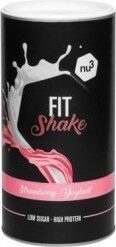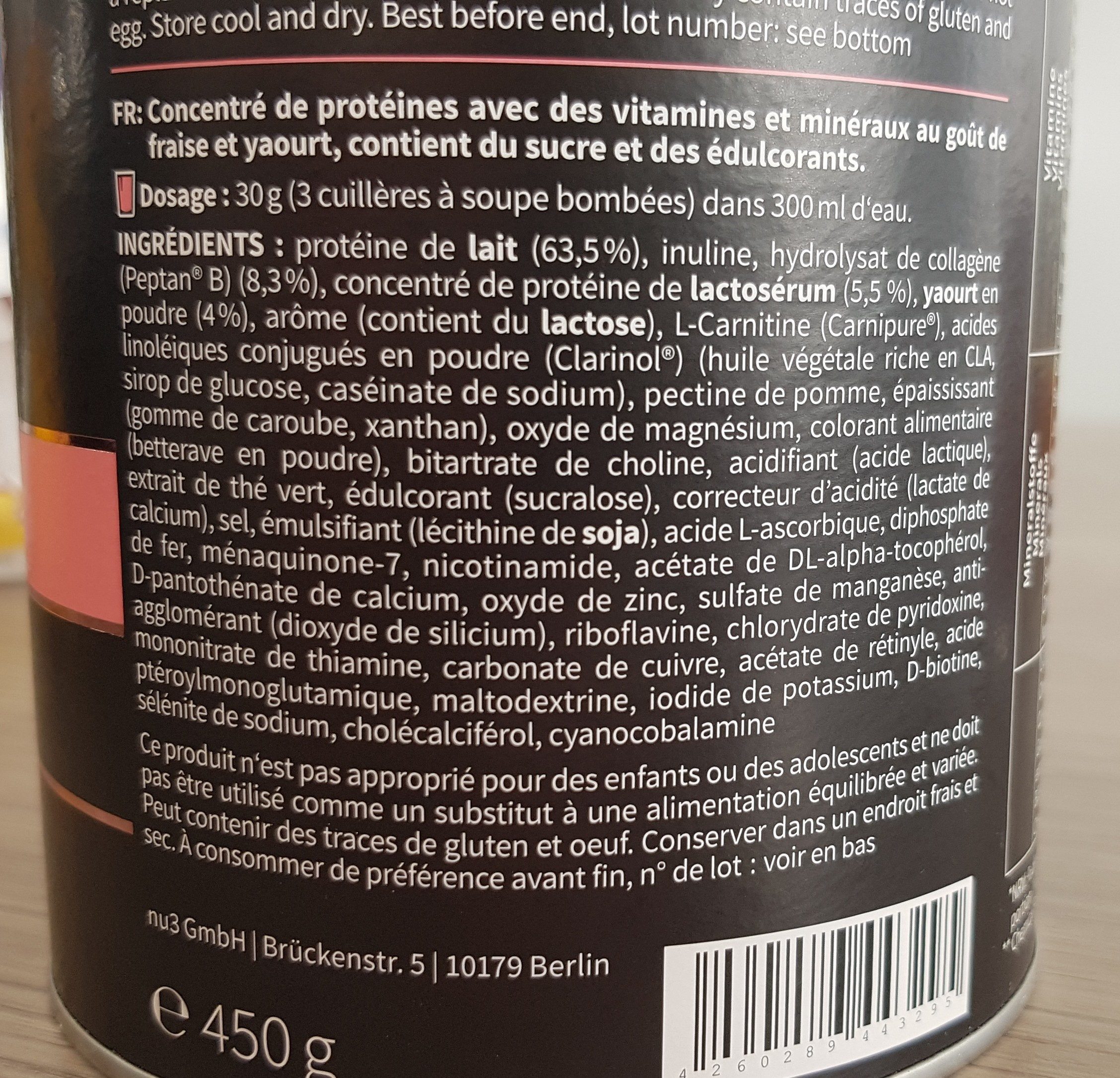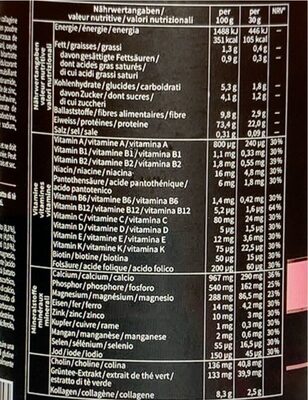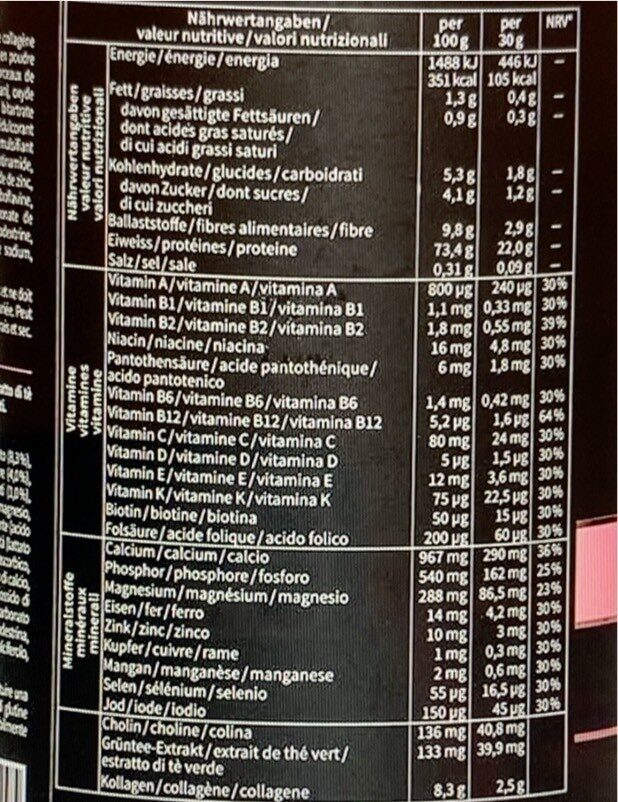Help us make food transparency the norm!
As a non-profit organization, we depend on your donations to continue informing consumers around the world about what they eat.
The food revolution starts with you!
Nu3 Fit Shake Fraise Yaourt
Nu3 Fit Shake Fraise Yaourt
This product page is not complete. You can help to complete it by editing it and adding more data from the photos we have, or by taking more photos using the app for Android or iPhone/iPad. Thank you!
×
Barcode: 4260289443295 (EAN / EAN-13)
Brands: Nu3
Categories: Dietary supplements, Bodybuilding supplements, Protein powders
Countries where sold: France
Matching with your preferences
Health
Ingredients
-
54 ingredients
: protéine de lait (63,5%), inuline, hydrolysat de collagène (Peptan@ B) (8,3%), concentré de protéine de lactosérum (5,5 %), yaourten poudre (4%), arôme (contient du lactose), acides linoléiques conjugués en poudre (Clarinol@) (huile végétale riche en CLAY sirop de glucose, caséinate de sodium), pectine de pomme, épaississant (gomme de caroube, xanthan), oxyde de magnésium, colorant alimentaire (betterave en poudre), bitartrate de choline, acidifiant (acide lactique), extrait de thé vert, édulcorant (sucralose), correcteur d'acidité (lactate de calcium), sel, émulsifiant (lécithine de soja), acide L-ascorbique, diphosphate de fer, ménaquinone-7, nicotinamide, acétate de DL - alpha-tocophégl, D-pantothénate de calcium, oxyde de zinc, sulfate de manganèse, agglomérant (dioxyde de silicium), riboflavine, chlorydrate de pyridoxine' mononitrate de thiamine, carbonate de cuivre, acétate de rétinyley acide Ptéroylmonoglutamique, maltodextrine, iodide de potassium, D-biotine, sélénite de sodium, cholécalciférol, cyanocoba la mine Ce Produitn'est pas approprié pour des enfants ou des adolescents etned?lt utilisé comme un substitut à une alimentation équilibrée traces de gluten et oeuf. Conserver dans un Sec. Aconsommer de préférence avant fin, no de lot : voir en bas nu3GmbH I Brückenstr, 5 | 10179 Berlin e 450 gAllergens: Milk, SoybeansTraces: Eggs, Gluten
Food processing
-
Ultra processed foods
Elements that indicate the product is in the 4 - Ultra processed food and drink products group:
- Additive: E322 - Lecithins
- Additive: E327 - Calcium lactate
- Additive: E410 - Locust bean gum
- Additive: E440 - Pectins
- Additive: E955 - Sucralose
- Ingredient: Colour
- Ingredient: Emulsifier
- Ingredient: Flavouring
- Ingredient: Maltodextrin
- Ingredient: Milk proteins
- Ingredient: Sweetener
- Ingredient: Thickener
Food products are classified into 4 groups according to their degree of processing:
- Unprocessed or minimally processed foods
- Processed culinary ingredients
- Processed foods
- Ultra processed foods
The determination of the group is based on the category of the product and on the ingredients it contains.
Additives
-
E270 - Lactic acid
Lactic acid: Lactic acid is an organic compound with the formula CH3CH-OH-COOH. In its solid state, it is white and water-soluble. In its liquid state, it is colorless. It is produced both naturally and synthetically. With a hydroxyl group adjacent to the carboxyl group, lactic acid is classified as an alpha-hydroxy acid -AHA-. In the form of its conjugate base called lactate, it plays a role in several biochemical processes. In solution, it can ionize a proton from the carboxyl group, producing the lactate ion CH3CH-OH-CO−2. Compared to acetic acid, its pKa is 1 unit less, meaning lactic acid deprotonates ten times more easily than acetic acid does. This higher acidity is the consequence of the intramolecular hydrogen bonding between the α-hydroxyl and the carboxylate group. Lactic acid is chiral, consisting of two optical isomers. One is known as L--+--lactic acid or -S--lactic acid and the other, its mirror image, is D--−--lactic acid or -R--lactic acid. A mixture of the two in equal amounts is called DL-lactic acid, or racemic lactic acid. Lactic acid is hygroscopic. DL-lactic acid is miscible with water and with ethanol above its melting point which is around 17 or 18 °C. D-lactic acid and L-lactic acid have a higher melting point. In animals, L-lactate is constantly produced from pyruvate via the enzyme lactate dehydrogenase -LDH- in a process of fermentation during normal metabolism and exercise. It does not increase in concentration until the rate of lactate production exceeds the rate of lactate removal, which is governed by a number of factors, including monocarboxylate transporters, concentration and isoform of LDH, and oxidative capacity of tissues. The concentration of blood lactate is usually 1–2 mM at rest, but can rise to over 20 mM during intense exertion and as high as 25 mM afterward. In addition to other biological roles, L-lactic acid is the primary endogenous agonist of hydroxycarboxylic acid receptor 1 -HCA1-, which is a Gi/o-coupled G protein-coupled receptor -GPCR-.In industry, lactic acid fermentation is performed by lactic acid bacteria, which convert simple carbohydrates such as glucose, sucrose, or galactose to lactic acid. These bacteria can also grow in the mouth; the acid they produce is responsible for the tooth decay known as caries. In medicine, lactate is one of the main components of lactated Ringer's solution and Hartmann's solution. These intravenous fluids consist of sodium and potassium cations along with lactate and chloride anions in solution with distilled water, generally in concentrations isotonic with human blood. It is most commonly used for fluid resuscitation after blood loss due to trauma, surgery, or burns.Source: Wikipedia
-
E322 - Lecithins
Lecithins are natural compounds commonly used in the food industry as emulsifiers and stabilizers.
Extracted from sources like soybeans and eggs, lecithins consist of phospholipids that enhance the mixing of oil and water, ensuring smooth textures in various products like chocolates, dressings, and baked goods.
They do not present any known health risks.
-
E322i - Lecithin
Lecithins are natural compounds commonly used in the food industry as emulsifiers and stabilizers.
Extracted from sources like soybeans and eggs, lecithins consist of phospholipids that enhance the mixing of oil and water, ensuring smooth textures in various products like chocolates, dressings, and baked goods.
They do not present any known health risks.
-
E327 - Calcium lactate
Calcium lactate: Calcium lactate is a white crystalline salt with formula C6H10CaO6, consisting of two lactate anions H3C-CHOH-CO−2 for each calcium cation Ca2+. It forms several hydrates, the most common being the pentahydrate C6H10CaO6·5H2O. Calcium lactate is used in medicine, mainly to treat calcium deficiencies; and as a food additive with E number of E327. Some cheese crystals consist of calcium lactate.Source: Wikipedia
-
E410 - Locust bean gum
Locust bean gum: Locust bean gum -LBG, also known as carob gum, carob bean gum, carobin, E410- is a thickening agent and a gelling agent used in food technology.Source: Wikipedia
-
E440 - Pectins
Pectins (E440) are natural carbohydrates, predominantly found in fruits, that act as gelling agents in the food industry, creating the desirable jelly-like texture in jams, jellies, and marmalades.
Pectins stabilize and thicken various food products, such as desserts, confectioneries, and beverages, ensuring a uniform consistency and quality.
Recognized as safe by various health authorities, pectins have been widely used without notable adverse effects when consumed in typical dietary amounts.
-
E955 - Sucralose
Sucralose: Sucralose is an artificial sweetener and sugar substitute. The majority of ingested sucralose is not broken down by the body, so it is noncaloric. In the European Union, it is also known under the E number E955. It is produced by chlorination of sucrose. Sucralose is about 320 to 1‚000 times sweeter than sucrose, three times as sweet as both aspartame and acesulfame potassium, and twice as sweet as sodium saccharin. Evidence of benefit is lacking for long-term weight loss with some data supporting weight gain and heart disease risks.It is stable under heat and over a broad range of pH conditions. Therefore, it can be used in baking or in products that require a long shelf life. The commercial success of sucralose-based products stems from its favorable comparison to other low-calorie sweeteners in terms of taste, stability, and safety. Common brand names of sucralose-based sweeteners are Splenda, Zerocal, Sukrana, SucraPlus, Candys, Cukren, and Nevella. Canderel Yellow also contains sucralose, but the original Canderel and Green Canderel do not.Source: Wikipedia
Ingredients analysis
-
Palm oil content unknown
Unrecognized ingredients: fr:hydrolysat-de-collagene, fr:peptan-b, fr:yaourten-poudre, fr:acides-linoleiques-conjugues-en-poudre, fr:clarinol, fr:huile-vegetale-riche-en-clay-sirop-de-glucose, fr:xanthan, fr:menaquinone-7, fr:acetate-de-dl, fr:alpha-tocophegl, fr:agglomerant, fr:chlorydrate-de-pyridoxine-mononitrate-de-thiamine, fr:acetate-de-retinyley-acide-pteroylmonoglutamique, fr:iodide-de-potassium, fr:conserver-dans-un-sec, fr:aconsommer-de-preference-avant-fin, fr:no-de-lot, fr:voir-en-bas-nu3gmbh-i-bruckenstr, fr:5-10179-berlin-e450gSome ingredients could not be recognized.
We need your help!
You can help us recognize more ingredients and better analyze the list of ingredients for this product and others:
- Edit this product page to correct spelling mistakes in the ingredients list, and/or to remove ingredients in other languages and sentences that are not related to the ingredients.
- Add new entries, synonyms or translations to our multilingual lists of ingredients, ingredient processing methods, and labels.
If you would like to help, join the #ingredients channel on our Slack discussion space and/or learn about ingredients analysis on our wiki. Thank you!
-
Non-vegan
Non-vegan ingredients: Milk proteins, Concentrated whey protein, Sodium caseinateSome ingredients could not be recognized.
We need your help!
You can help us recognize more ingredients and better analyze the list of ingredients for this product and others:
- Edit this product page to correct spelling mistakes in the ingredients list, and/or to remove ingredients in other languages and sentences that are not related to the ingredients.
- Add new entries, synonyms or translations to our multilingual lists of ingredients, ingredient processing methods, and labels.
If you would like to help, join the #ingredients channel on our Slack discussion space and/or learn about ingredients analysis on our wiki. Thank you!
-
Vegetarian status unknown
Unrecognized ingredients: fr:hydrolysat-de-collagene, fr:peptan-b, fr:yaourten-poudre, fr:acides-linoleiques-conjugues-en-poudre, fr:clarinol, fr:huile-vegetale-riche-en-clay-sirop-de-glucose, fr:xanthan, Ferric diphosphate, fr:menaquinone-7, fr:acetate-de-dl, fr:alpha-tocophegl, Zinc oxide, Manganese sulfate, fr:agglomerant, fr:chlorydrate-de-pyridoxine-mononitrate-de-thiamine, Cupric carbonate, fr:acetate-de-retinyley-acide-pteroylmonoglutamique, fr:iodide-de-potassium, Sodium selenite, fr:conserver-dans-un-sec, fr:aconsommer-de-preference-avant-fin, fr:no-de-lot, fr:voir-en-bas-nu3gmbh-i-bruckenstr, fr:5-10179-berlin-e450gSome ingredients could not be recognized.
We need your help!
You can help us recognize more ingredients and better analyze the list of ingredients for this product and others:
- Edit this product page to correct spelling mistakes in the ingredients list, and/or to remove ingredients in other languages and sentences that are not related to the ingredients.
- Add new entries, synonyms or translations to our multilingual lists of ingredients, ingredient processing methods, and labels.
If you would like to help, join the #ingredients channel on our Slack discussion space and/or learn about ingredients analysis on our wiki. Thank you!
-
Details of the analysis of the ingredients
We need your help!
Some ingredients could not be recognized.
We need your help!
You can help us recognize more ingredients and better analyze the list of ingredients for this product and others:
- Edit this product page to correct spelling mistakes in the ingredients list, and/or to remove ingredients in other languages and sentences that are not related to the ingredients.
- Add new entries, synonyms or translations to our multilingual lists of ingredients, ingredient processing methods, and labels.
If you would like to help, join the #ingredients channel on our Slack discussion space and/or learn about ingredients analysis on our wiki. Thank you!
: protéine de lait 63.5%, inuline, hydrolysat de collagène (Peptan@ B), concentré de protéine de lactosérum 5.5%, yaourten poudre 4%, arôme, acides linoléiques conjugués en poudre (Clarinol@, huile végétale riche en CLAY sirop de glucose, caséinate de sodium), pectine de pomme, épaississant (gomme de caroube, xanthan), oxyde de magnésium, colorant alimentaire (betterave), bitartrate de choline, acidifiant (acide lactique), extrait de thé vert, édulcorant (sucralose), correcteur d'acidité (lactate de calcium), sel, émulsifiant (lécithine de soja), acide L-ascorbique, diphosphate de fer, ménaquinone-7, nicotinamide, acétate de DL, alpha-tocophégl, D-pantothénate de calcium, oxyde de zinc, sulfate de manganèse, agglomérant (dioxyde de silicium), riboflavine, chlorydrate de pyridoxine' mononitrate de thiamine, carbonate de cuivre, acétate de rétinyley acide Ptéroylmonoglutamique, maltodextrine, iodide de potassium, D-biotine, sélénite de sodium, cholécalciférol, Conserver dans un Sec, Aconsommer de préférence avant fin, no de lot (voir en bas nu3GmbH I Brückenstr), 5 | 10179 Berlin e450g- protéine de lait -> en:milk-proteins - vegan: no - vegetarian: yes - percent_min: 63.5 - percent: 63.5 - percent_max: 63.5
- inuline -> en:inulin - vegan: yes - vegetarian: yes - percent_min: 5.5 - percent_max: 21.5
- hydrolysat de collagène -> fr:hydrolysat-de-collagene - percent_min: 5.5 - percent_max: 21.5
- Peptan@ B -> fr:peptan-b - percent_min: 5.5 - percent_max: 21.5
- concentré de protéine de lactosérum -> en:concentrated-whey-protein - vegan: no - vegetarian: yes - percent_min: 5.5 - percent: 5.5 - percent_max: 5.5
- yaourten poudre -> fr:yaourten-poudre - percent_min: 4 - percent: 4 - percent_max: 4
- arôme -> en:flavouring - vegan: maybe - vegetarian: maybe - percent_min: 0 - percent_max: 4
- acides linoléiques conjugués en poudre -> fr:acides-linoleiques-conjugues-en-poudre - percent_min: 0 - percent_max: 4
- Clarinol@ -> fr:clarinol - percent_min: 0 - percent_max: 4
- huile végétale riche en CLAY sirop de glucose -> fr:huile-vegetale-riche-en-clay-sirop-de-glucose - percent_min: 0 - percent_max: 2
- caséinate de sodium -> en:sodium-caseinate - vegan: no - vegetarian: yes - percent_min: 0 - percent_max: 1.33333333333333
- pectine de pomme -> en:apple-pectin - vegan: yes - vegetarian: yes - ciqual_food_code: 13050 - percent_min: 0 - percent_max: 3.58333333333333
- épaississant -> en:thickener - percent_min: 0 - percent_max: 3.07142857142857
- gomme de caroube -> en:e410 - vegan: yes - vegetarian: yes - percent_min: 0 - percent_max: 3.07142857142857
- xanthan -> fr:xanthan - percent_min: 0 - percent_max: 1.53571428571429
- oxyde de magnésium -> en:e530 - vegan: yes - vegetarian: yes - percent_min: 0 - percent_max: 2.6875
- colorant alimentaire -> en:colour - percent_min: 0 - percent_max: 2.38888888888889
- betterave -> en:beetroot - vegan: yes - vegetarian: yes - ciqual_proxy_food_code: 20091 - percent_min: 0 - percent_max: 2.38888888888889
- bitartrate de choline -> en:choline-bitartrate - vegan: maybe - vegetarian: maybe - percent_min: 0 - percent_max: 2.15
- acidifiant -> en:acid - percent_min: 0 - percent_max: 1.95454545454545
- acide lactique -> en:e270 - vegan: yes - vegetarian: yes - percent_min: 0 - percent_max: 1.95454545454545
- extrait de thé vert -> en:green-tea-extract - vegan: yes - vegetarian: yes - ciqual_food_code: 18155 - percent_min: 0 - percent_max: 1.79166666666667
- édulcorant -> en:sweetener - percent_min: 0 - percent_max: 1.65384615384615
- sucralose -> en:e955 - vegan: yes - vegetarian: yes - percent_min: 0 - percent_max: 1.65384615384615
- correcteur d'acidité -> en:acidity-regulator - percent_min: 0 - percent_max: 1.53571428571429
- lactate de calcium -> en:e327 - vegan: yes - vegetarian: yes - percent_min: 0 - percent_max: 1.53571428571429
- sel -> en:salt - vegan: yes - vegetarian: yes - ciqual_food_code: 11058 - percent_min: 0 - percent_max: 0.31
- émulsifiant -> en:emulsifier - percent_min: 0 - percent_max: 0.31
- lécithine de soja -> en:soya-lecithin - vegan: yes - vegetarian: yes - ciqual_food_code: 42200 - percent_min: 0 - percent_max: 0.31
- acide L-ascorbique -> en:e300 - vegan: yes - vegetarian: yes - percent_min: 0 - percent_max: 0.31
- diphosphate de fer -> en:ferric-diphosphate - percent_min: 0 - percent_max: 0.31
- ménaquinone-7 -> fr:menaquinone-7 - percent_min: 0 - percent_max: 0.31
- nicotinamide -> en:e375 - vegan: maybe - vegetarian: maybe - percent_min: 0 - percent_max: 0.31
- acétate de DL -> fr:acetate-de-dl - percent_min: 0 - percent_max: 0.31
- alpha-tocophégl -> fr:alpha-tocophegl - percent_min: 0 - percent_max: 0.31
- D-pantothénate de calcium -> en:d-pantothenate-calcium - vegan: yes - vegetarian: yes - percent_min: 0 - percent_max: 0.31
- oxyde de zinc -> en:zinc-oxide - percent_min: 0 - percent_max: 0.31
- sulfate de manganèse -> en:manganese-sulfate - percent_min: 0 - percent_max: 0.31
- agglomérant -> fr:agglomerant - percent_min: 0 - percent_max: 0.31
- dioxyde de silicium -> en:e551 - vegan: yes - vegetarian: yes - percent_min: 0 - percent_max: 0.31
- riboflavine -> en:e101 - vegan: maybe - vegetarian: yes - percent_min: 0 - percent_max: 0.31
- chlorydrate de pyridoxine' mononitrate de thiamine -> fr:chlorydrate-de-pyridoxine-mononitrate-de-thiamine - percent_min: 0 - percent_max: 0.31
- carbonate de cuivre -> en:cupric-carbonate - percent_min: 0 - percent_max: 0.31
- acétate de rétinyley acide Ptéroylmonoglutamique -> fr:acetate-de-retinyley-acide-pteroylmonoglutamique - percent_min: 0 - percent_max: 0.31
- maltodextrine -> en:maltodextrin - vegan: yes - vegetarian: yes - percent_min: 0 - percent_max: 0.31
- iodide de potassium -> fr:iodide-de-potassium - percent_min: 0 - percent_max: 0.31
- D-biotine -> en:biotin - vegan: yes - vegetarian: yes - percent_min: 0 - percent_max: 0.31
- sélénite de sodium -> en:sodium-selenite - percent_min: 0 - percent_max: 0.31
- cholécalciférol -> en:cholecalciferol - vegan: maybe - vegetarian: maybe - percent_min: 0 - percent_max: 0.31
- Conserver dans un Sec -> fr:conserver-dans-un-sec - percent_min: 0 - percent_max: 0.31
- Aconsommer de préférence avant fin -> fr:aconsommer-de-preference-avant-fin - percent_min: 0 - percent_max: 0.31
- no de lot -> fr:no-de-lot - percent_min: 0 - percent_max: 0.31
- voir en bas nu3GmbH I Brückenstr -> fr:voir-en-bas-nu3gmbh-i-bruckenstr - percent_min: 0 - percent_max: 0.31
- 5 | 10179 Berlin e450g -> fr:5-10179-berlin-e450g - percent_min: 0 - percent_max: 0.31
Nutrition
-
Very good nutritional quality
⚠ ️Warning: the amount of fruits, vegetables and nuts is not specified on the label, it was estimated from the list of ingredients: 0This product is not considered a beverage for the calculation of the Nutri-Score.
Positive points: 10
- Proteins: 5 / 5 (value: 73.4, rounded value: 73.4)
- Fiber: 5 / 5 (value: 9.8, rounded value: 9.8)
- Fruits, vegetables, nuts, and colza/walnut/olive oils: 0 / 5 (value: 0, rounded value: 0)
Negative points: 5
- Energy: 4 / 10 (value: 1469, rounded value: 1469)
- Sugars: 0 / 10 (value: 4.1, rounded value: 4.1)
- Saturated fat: 0 / 10 (value: 0.9, rounded value: 0.9)
- Sodium: 1 / 10 (value: 124, rounded value: 124)
The points for proteins are counted because the negative points are less than 11.
Nutritional score: (5 - 10)
Nutri-Score:
-
Nutrient levels
-
Fat in low quantity (1.3%)
What you need to know- A high consumption of fat, especially saturated fats, can raise cholesterol, which increases the risk of heart diseases.
Recommendation: Limit the consumption of fat and saturated fat- Choose products with lower fat and saturated fat content.
-
Saturated fat in low quantity (0.9%)
What you need to know- A high consumption of fat, especially saturated fats, can raise cholesterol, which increases the risk of heart diseases.
Recommendation: Limit the consumption of fat and saturated fat- Choose products with lower fat and saturated fat content.
-
Sugars in low quantity (4.1%)
What you need to know- A high consumption of sugar can cause weight gain and tooth decay. It also augments the risk of type 2 diabetes and cardio-vascular diseases.
Recommendation: Limit the consumption of sugar and sugary drinks- Sugary drinks (such as sodas, fruit beverages, and fruit juices and nectars) should be limited as much as possible (no more than 1 glass a day).
- Choose products with lower sugar content and reduce the consumption of products with added sugars.
-
Salt in moderate quantity (0.31%)
What you need to know- A high consumption of salt (or sodium) can cause raised blood pressure, which can increase the risk of heart disease and stroke.
- Many people who have high blood pressure do not know it, as there are often no symptoms.
- Most people consume too much salt (on average 9 to 12 grams per day), around twice the recommended maximum level of intake.
Recommendation: Limit the consumption of salt and salted food- Reduce the quantity of salt used when cooking, and don't salt again at the table.
- Limit the consumption of salty snacks and choose products with lower salt content.
-
-
Nutrition facts
Nutrition facts As sold
for 100 g / 100 mlCompared to: Protein powders Energy 1,469 kj
(351 kcal)-3% Fat 1.3 g -70% Saturated fat 0.9 g -49% Carbohydrates 5.38 g -33% Sugars 4.1 g +27% Fiber 9.8 g +205% Proteins 73.4 g +4% Salt 0.31 g -61% Fruits‚ vegetables‚ nuts and rapeseed‚ walnut and olive oils (estimate from ingredients list analysis) 0 %
Environment
-
Eco-Score not computed - Unknown environmental impact
We could not compute the Eco-Score of this product as it is missing some data, could you help complete it?Could you add a precise product category so that we can compute the Eco-Score? Add a category
Packaging
-
Missing packaging information for this product
⚠ ️ The information about the packaging of this product is not filled in.Take a photo of the recycling information Take a photo of the recycling information
Transportation
-
Origins of ingredients
Missing origins of ingredients information
⚠ ️ The origins of the ingredients of this product are not indicated.
If they are indicated on the packaging, you can modify the product sheet and add them.
If you are the manufacturer of this product, you can send us the information with our free platform for producers.Add the origins of ingredients for this product Add the origins of ingredients for this product
Report a problem
-
Incomplete or incorrect information?
Category, labels, ingredients, allergens, nutritional information, photos etc.
If the information does not match the information on the packaging, please complete or correct it. Open Food Facts is a collaborative database, and every contribution is useful for all.
Data sources
Product added on by kiliweb
Last edit of product page on by cfgym69.
Product page also edited by openfoodfacts-contributors, yuka.Fex9Z46iE80nFsbx19wYhAO3OuzCGa90IEEXoQ, yuka.Kpd5EYeOOd0zBsGC7d8X5yWcDOzBUtByJXkAog, yuka.UKsTHfjUNe0FF8Xv_tto4GjlT8DqP69-OCYoog, yuka.UVl3cVA0c1ppL1VRa3RzQjJ4S1AxdkZ2NGEyd1pFNk9CZTVQSVE9PQ, yuka.Um9NWUw0NFlqZGNZZ3ZJKzVqN2wrdU5jeXBQMUFrS0xLY29WSVE9PQ, yuka.sY2b0xO6T85zoF3NwEKvlk0dVd_RqAPbNTbQkhCvyfmidaP4SI1rxJnWHqo, yuka.sY2b0xO6T85zoF3NwEKvlm0XDP_ZnjjFER_ioEKmzOmWdafkW_JSyaLoGas.










